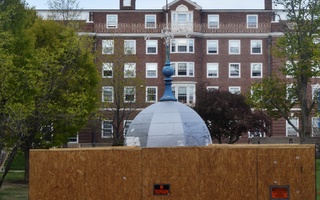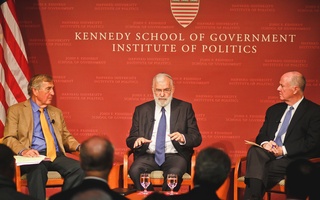
HMS faculty member and pediatrician Mark Waltzman treats a laceration on the head of a child eight days after he was injured in an earthquake which killed thousands.
Around midnight on Dec. 26, Susan M. Briggs, a surgeon on the Harvard Medical School (HMS) faculty, received a telephone call from the Federal Emergency Management Agency (FEMA), a branch of the U.S. Department of Homeland Security.
An earthquake of magnitude 6.6 had just destroyed the city of Bam in Iran. Briggs and a team of doctors, more than half of whom were from HMS, assembled that morning, obtained enough equipment and supplies to set up a field hospital, and arrived in Iran on Dec. 29.
After treating 727 patients and performing eight operations in Bam, the elite team of doctors returned to Boston last week, bearing descriptions of immense suffering and of operations undertaken in the most primitive conditions.
With an official U.S. delegation by Sen. Elizabeth Dole, R-N.C., denied entry by Iran’s government, the Boston-based team was among a small group of Americans who traveled to the remote southeastern city to care for the victims of the earthquake, which killed approximately 30,000.
The team of 57 trauma surgeons, pediatricians and nurses were the first Americans to travel to Iran in an official capacity since the 1979 Islamic Revolution and hostage crisis.
“The minute [the Bam residents] heard we were there, we were mobbed,” said Annekathryn Goodman, a gynecologic oncologist at Massachusetts General Hospital and associate professor at HMS.
Many of the victims waited in cardboard boxes or tents on the street for medical treatment.
“The hospital had been destroyed, the doctors had been killed, all the resources of Bam were destroyed,” Goodman said.
As Bam’s infrastructure was leveled, the relief team had to cope with very limited resources. The team performed surgeries with bottled water and built shelves out of cardboard boxes held by duct tape.
According to Mark L. Waltzman, a pediatrician at Children’s Hospital and member of the HMS faculty, the doctors, foregoing standard testing procedures, relied on physical examination, past experience and intuition to treat patients.
“We diagnosed a couple of children with bleeding inside the skull, just based on their history and physical exams, and we managed to transport them to Tehran for surgery,” Waltzman said. “If it were here, we would have gotten CAT scans and neurosurgeons at [their] beside,” he added.
According to Waltzman, there were no fatalities at the field hospital during its time of operation.
The disaster response team, founded and headed by Briggs, had previously been deployed to lower Manhattan after the Sept. 11, 2001 attacks and to Guam after the December 2002 typhoon.
The team had been on alert for five days prior to the Iran earthquake due to the U.S. terrorism alert, according to Briggs.
The team was created in 2000 in response to the bombings of the U.S. embassies in Kenya and Tanzania. The team’s deployment to Iran was its first trip to a foreign country.
Read more in News
Chapel May Remain in Cambridge PermanentlyRecommended Articles
-
Few Dorms Use Full ParietalsFew Radcliffe dorms have voted to accept the maximum number of parietal hours permitted by a recent RGA decision. Barnard
-
Quaker Racquetmen Take Six-Man Title(Special to the CRIMSON) WILLIAMSTOWN, Mass., March 7-Penn's varsity squash team won four consecutive head-to-head matches with the Crimson Saturday
-
Cindermen Compete in N. Y. Millrose Meet and StadiumThe Crimson Varsity track forces swing into action today with the Millrose Games at New York, and the New England
-
Colossal Mountains on the Eve of LifeAnd what is the best life? Attempting to answer that would be, say, like trying to climb a mountain for the sake of climbing a mountain.
-
 Cabot House to Place Time Capsule in Cupola
Cabot House to Place Time Capsule in Cupola -
 Forum Looks at Approaches to ISIS, Iran
Forum Looks at Approaches to ISIS, Iran













